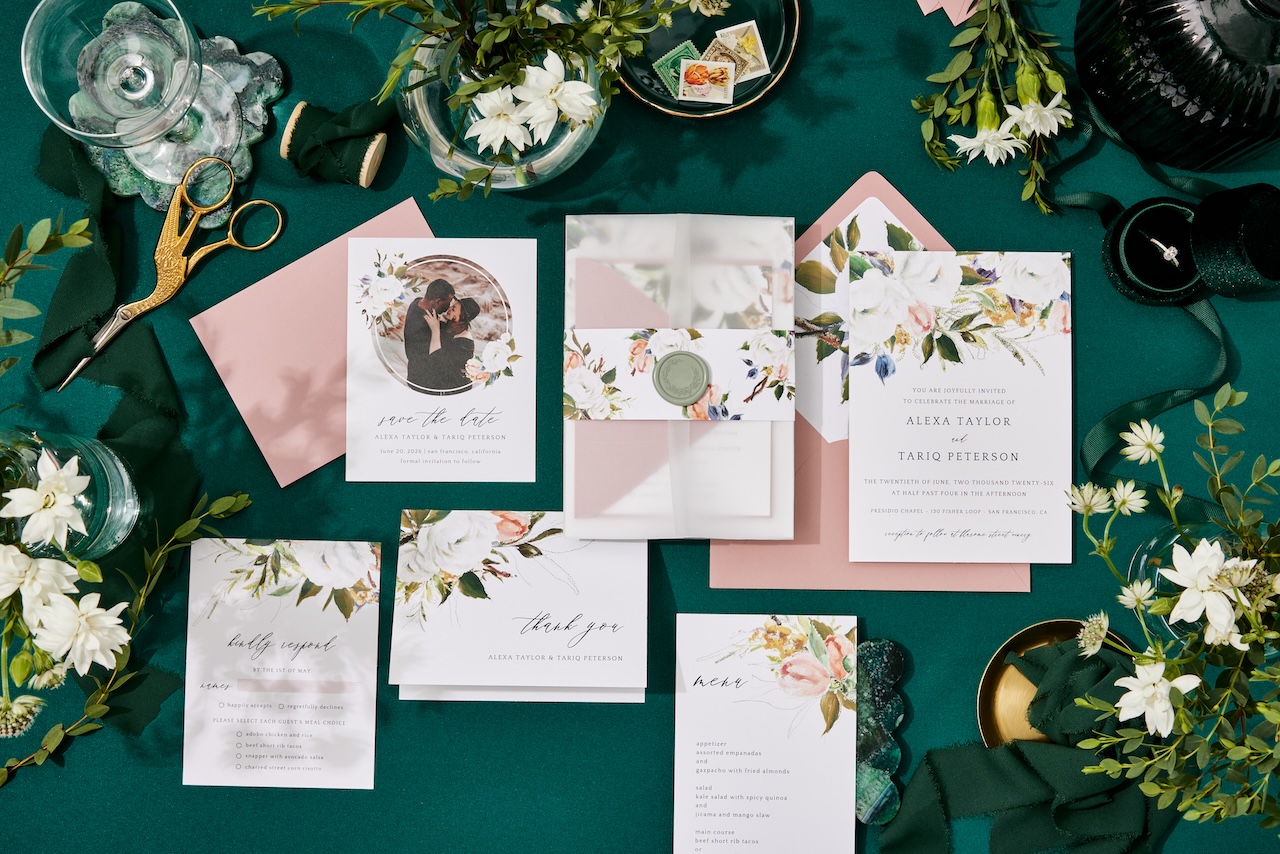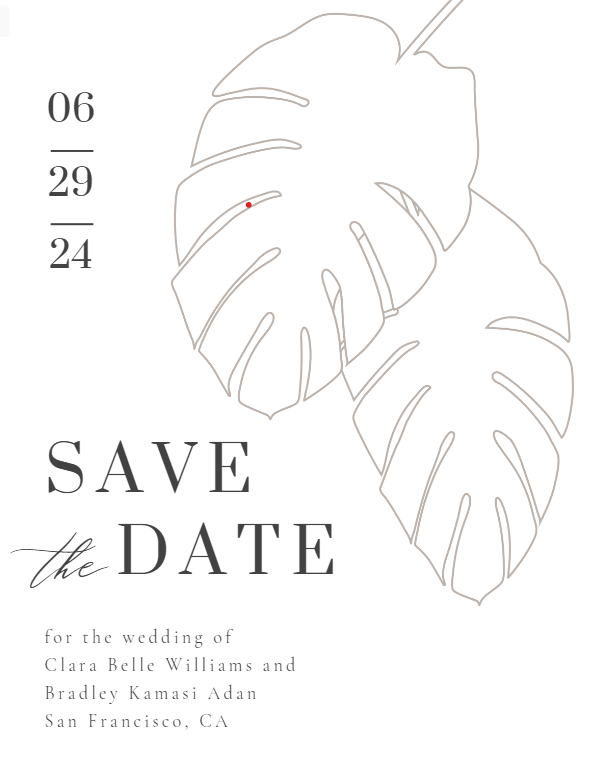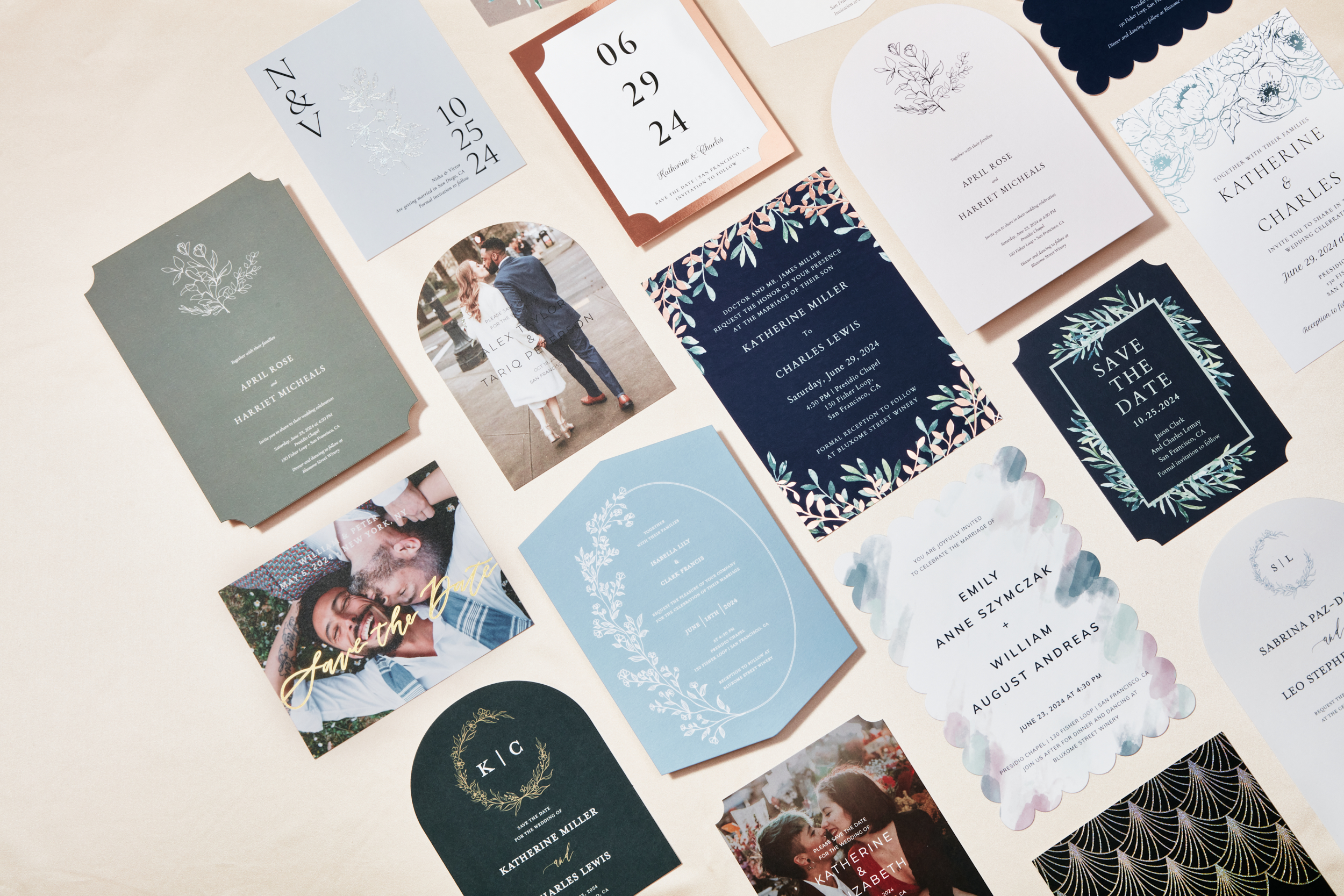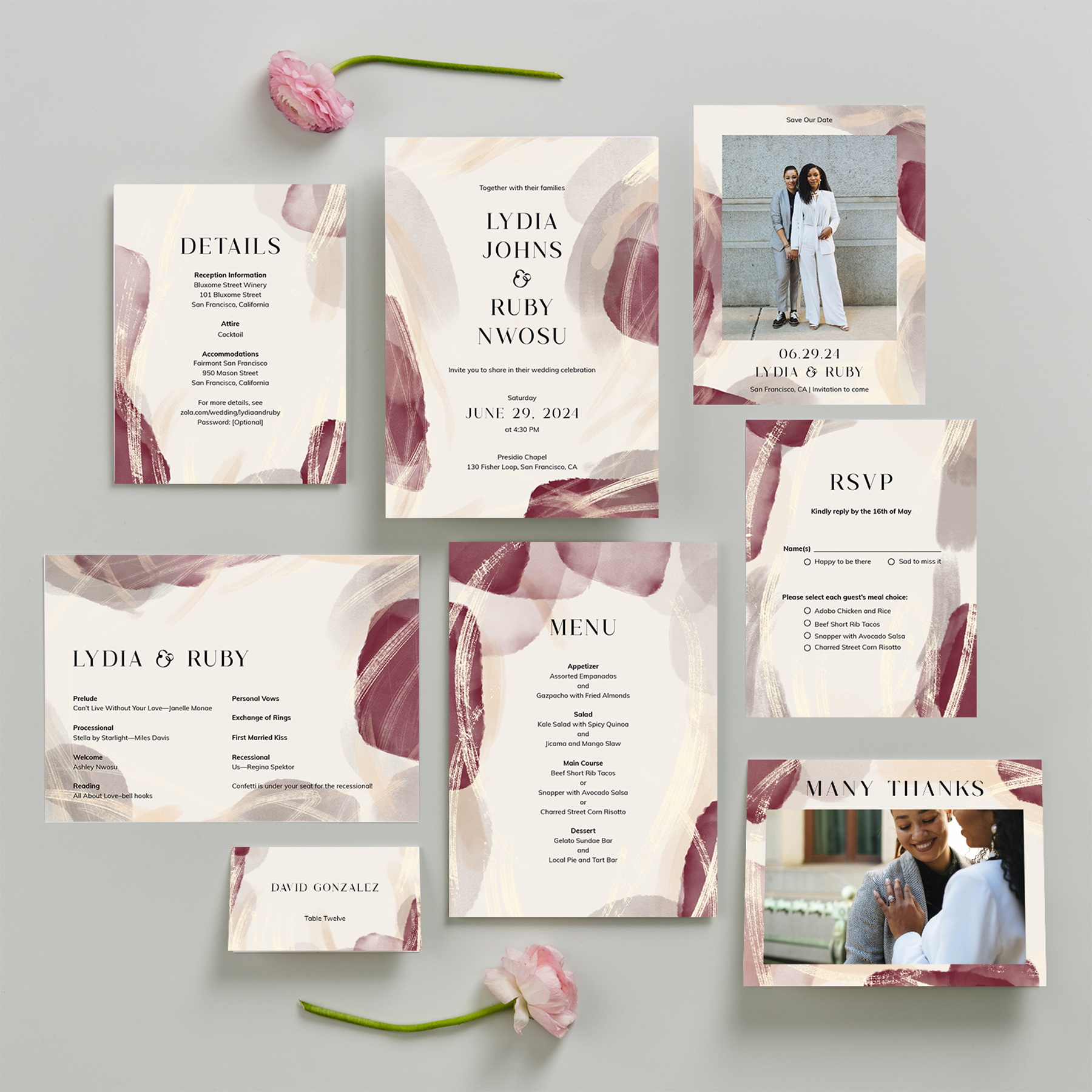- Expert advice/
- Invites & paper/
- Invitations/
- The Ultimate Guide to Wedding Invitations and Paper
- Invitations
The Ultimate Guide to Wedding Invitations and Paper
Here’s everything you need to know about wedding invitations, save the dates, wedding stationery, and wedding party invites–plus expert tips for creating, ordering and sending them.
Last updated July 1, 2025

Shop invitations
View allThere’s nothing quite like getting wedding invitations or save the dates in the mail. We all love the anticipation as we open them, read the event details, and feel all the feels as we mark our calendars.
But when you’re actually the one planning the wedding, there’s a whole other side to wedding invitations that you’ve likely never thought of. *Until now. *
Suddenly your mind is racing. How many wedding invitations will you need? Do you need backup wedding invitations? How much is postage, anyway? How much of your wedding budget is allocated for wedding invitations and wedding stationery? When do you have to order them?
From solidifying your most important details to figuring out what to put in your invitation suite, plus who to invite and how to invite them, here’s our complete guide to wedding invitations and paper.
5 Details you need to know before ordering your wedding invitations
Not sure where to begin? We get that. Start by thinking through these 5 details.
1. Your wedding date
This one might be obvious, but it might just be the most important piece of information on your wedding invitations, aside from who you’re marrying. Make sure your wedding date is officially locked in before you design and order your save the dates or wedding invitations. If there’s any question about the date, or if you’re only penciled in at the venue, hold off on making any moves until you know for certain. Trust us.
2. Location and start times of ceremony and reception
Once the date is settled, the other important info follows. The location and start times of both your ceremony and reception (especially if they’re at different locations) should be set in stone before you place your wedding invitation order.
If you’re in between times or not sure if you’ll have the ceremony on-site, you aren’t ready to order wedding invitations. However, as long as you have your date and wedding venue secured, you can order your save the date cards.
Expert Advice: You might also want to build your wedding website before sending save the dates or wedding invitations. Zola offers free wedding websites and the option to add a QR code to your invitations that will take guests directly to your website when scanned!
3. How to word personal information
Ah, this one can be tricky and can feel a bit intimidating. When it comes to the wording of your name, your partner’s name, and your parent’s name(s) on the invites, there are two approaches.
To stick with tradition, the formal structure for wedding invitation wording is:
If one set of parents is hosting:
The parents’ names can appear first on the invitation.
Example: Mr. & Mrs. Edward Jones request the pleasure of your presence at the marriage of their daughter Katie Jones to Mr. John Smith, son of Mr. and Mrs. Michael Smith.
If both sets of parents are hosting:
You can include their names together.
Example: Mr. and Mrs. Edward Jones and Mr. and Mrs. Michael Smith request the pleasure of your presence at the marriage of their children, Katie Marie and John Peter.
If the couple is hosting it themselves:
When you’re paying for your own wedding, you can signify that by omitting any mention of your parents or families and keeping it simple.
Example: Katie Marie Jones and John Peter Smith request the pleasure of your presence at their wedding.
Of course, if neither parents are hosting but you still want to include their names, you can absolutely do that, too.
4. Total number of invitations you want to order
The number of invitations you’ll need to order will depend on the size of your guest list. So, you’ll want to have a good idea of how many people you’re inviting to your wedding before ordering save the dates or wedding invitations. But remember, you only need to send one invitation per couple or family that shares an address.
Expert Advice: The number of invitations you order should not, we repeat, should not, be the exact number you need. Always order at least 5-7 extra to account for any mishaps, errors, and late invitees. Plus, your photographer may want a clean copy for pictures, and you’ll also probably want to save a set for yourself as a cherished keepsake.
5. Your budget
In general, you can expect to spend between 2% and 5% of your entire wedding budget on wedding invitations and stationery, keeping in mind that this includes save-the-dates, invitations, postage, shower, party and brunch invitations, and RSVP cards. You’ll want to be mindful of your wedding budget in every wedding-related purchase, and track your expenses as you spend.
Save the dates

Wedding save the dates serve two purposes. Of course, they’re a way of letting your guests know that they’re invited to your upcoming wedding and to mark the date in their calendars. But they’re also your way of giving a sneak peek into your wedding day. You only need to include the basics — your names, your wedding date, and a general idea of the location. No need to be too specific or go into too much detail on a save the date card.
Many couples like their save the dates to match their invitation suite, which requires some advance planning. Others opt to use an engagement photo or even an assortment of photos to share the news. There aren’t nearly as many “rules” or components to consider with save the dates as there are wedding invitations, so try to have fun with it!
When should you order save the dates?
Ideally you want your save the dates to be received about 8 months before a destination wedding and 6 months before a local wedding, so ordering them about 2-3 weeks in advance is a safe bet.
Check out When to Send Save the Dates for a full explanation of when to order and send your date announcements.
Wedding invitations
Unlike wedding shower or engagement party invitations, wedding invitations are a bit more complex. Your wedding invitation includes all the information your guests need to know about the wedding—who, what, when and where.
Sometimes, but not always, people will match their wedding invitations to their save the dates and the rest of their wedding paper. At Zola, we offer fully customizable wedding invitations with hundreds of beautifully crafted templates and designs to get you started.
How to choose wedding invitations?

We always suggest that wedding invite designs reflect who you are as a couple, your love, or have hints from your big day woven in, like color themes or detailing. But there are truly no rules. In fact, you can get as custom as you like at Zola with our “upload your own design” option that lets you DIY your wedding invitation design.
Upload your desired image or design file, and customize the size, foil, shape, paper type, and other details.
How to address your wedding invitations?
Once you’ve finalized your guest list and have tracked down each address (try using our free Contact Collector tool to make that part easier!), it’s time to formally address your invitations. But with so many different prefixes, suffixes, pairings and unique guest situations, you might be wondering, what’s the right way to address your wedding invitations?
There are a lot of specifics when it comes to addressing your wedding invitations, but a few general rules include:
-
Full names instead of nicknames
-
Formal titles — avoid abbreviations
-
Address couples of the same sex as you would based on their preferred pronouns
-
If including children, address them by name
-
If inviting a single guest, make sure that is clear
-
Double check spelling
-
Triple check that the addresses are correct
What about families? Children? Those with special titles? See our article on How to Address Wedding Invitations: Etiquette & Examples for more on the nitty gritty grammar and style recommendations.
And to lighten your never-ending wedding planning to-do list even more, our Guest List Tool makes addressing invites super easy by displaying all your guest data in one convenient place (it can also seamlessly upload contact data from Excel). Best of all? It’s free.
When should you order wedding invitations?
In short? Earlier than you think. Here’s why.
Planning backwards can come in handy when it’s time to order wedding invitations. Start with your wedding date and count backwards 6-8 weeks (assuming you’ve already sent a save the date). That’s when your invitations should arrive in your guests’ mailboxes.
At Zola, the typical turnaround time to design and print wedding invites and paper is 1-3 business days. Shipping can take 5-10 business days, so you can reliably allow about 14 business days for your items to arrive after you place your order. But no worries, Zola will always give you an estimated arrival time when you add your order to your cart.
Then, give yourself as much time as you need to assemble the invitations, add postage, and get them out. Keep in mind that mail can take up to a full week to arrive in guests' mailboxes depending on where they live. Still with us?
Here’s a helpful example: If you’re getting married on January 1st, you should order your invitations about 11 weeks before, in early/mid October.
Expert Advice: Make sure you add a firm RSVP date to the invitation, and carefully track responses (or leave that to us! You can create events and track RSVPs online via your free Zola wedding website).
Wedding event and party invitations
While the wedding is, of course, the main event, there are also so many fun milestone events leading up to it that make the journey that much better.
Each event you’re planning — from your engagement party to the farewell brunch after your wedding — should have its own unique invitation to keep things clear and organized.
Sometimes, the bridal party or families will take care of the invitations for the bachelor or bachelorette party and the bridal showers (or Jack and Jill party). But for any wedding-related event you’re in charge of planning, you can find matching or complementary styles to keep all your wedding stationary cohesive (or mix and match!).
Day-of paper
When you’re planning for all your wedding paper and stationery needs, don’t forget to think of the big day itself! Items like menus, ceremony programs, welcome notes, table numbers, place cards — pretty much anything you want to convey to your guests as they enjoy your reception — will need a variety of day-of wedding stationary or signage.
Expert advice: Double check with your venue to see if they have day-of paper offerings included in your package. But if you want them to match your existing designs, you can always choose to use your own!
Thank you notes
We highly recommend ordering your wedding thank you notes ahead of time, unless you plan on using a photo from the wedding day.
Once you’ve said “I do,” the last thing you want to do is have another thing to cross off your list. Ordering your thank you notes along with your wedding invitations fixes two potential problems. First, they’ll match, and second, they’ll be at home and waiting for when you’re feeling super grateful and ready to share your gratitude.
Here, you can find out more about how to write your wedding thank you cards.
Wedding invitation suite

What’s included in a wedding invitation suite? Here are the essential components of a complete wedding invitation suite, including some optional “nice to haves” you might want to include. Often, couples will buy their thank you cards at the same time, so those are part of the coordinated suite, too.
- The wedding invitation itself (the main event! typically the largest inclusion)
- The RSVP Card (with a pre-addressed, stamped return envelope)
- Accommodation cards (gives information for where guest can stay overnight and how to make the reservations)
- Itinerary card (if you have a jam-packed wedding weekend with different events, you can outline them here)
- Attire Cards (includes guidance for guest’s attire)
- Reception Cards (gives all the details needed for the reception)
- Map / Directions card (you can include a handy map or written out directions for your guests that are driving.)
- Meal selection card (if your venue has suggested you give an estimated total for dinner selection)
- Song request card (a fun way to ask your guests to select a song they’d love to hear at your wedding)
- Belly bands (optional decorative accessory to keep all stationary neatly together)
- Inner and outer envelopes (the main envelope addressed to the guest and a pre-addressed stamped envelope for the return rsvp)
Note that you can combine many of the items above in a details or enclosure card vs several separate components of the suite. See our guide on wedding details cards for more info.
The world of wedding invitations is vast, and it can feel a bit overwhelming if you go it alone. With so much room for both creativity and personalization, the process of selecting, designing, and (finally!) sending out your wedding invitations should be more fun than it is stressful. That’s why Zola is with you every step of the way.
Want to stay organized and on-track throughout the whole wedding planning process? Introducing: The Ultimate Wedding Planning Checklist & Timeline.
FAQs about wedding invites
When to send wedding invitations?
For local-ish weddings, sending your invitations 6-8 weeks in advance is pretty standard. For destination weddings, give your guests ample time to prepare and make arrangements — send a save the date about a year in advance, followed by a wedding invitation that arrives at least four months before the big day.
See our article: When to Send Out Wedding Invitations.
When to send save the dates?
Send save the dates 4-6 months before a local wedding, and 8-12 months before a destination wedding. This will give your guests plenty of time to make arrangements, but not so much time that they forget about your big day.
See our article: When to Send Save the Dates.
Should I have a “B” list for my wedding invitations?
If you’ve signed an event contract for your wedding that includes a minimum headcount, you’ll pay for that number whether you reach it or not. Many couples create a “B” list, or alternative guest list of people to invite to replace any guests that RSVP “no.”
Some etiquette experts advise against this, as it can be difficult to manage and sometimes can appear obvious to the guests you’re inviting later that they weren’t a first choice. Others say it’s fine if it’s done properly.
But to avoid needing a “B” list in the first place, make sure you invite the right amount of people. While, of course, you can’t control who can come and who can’t, the general rule is to expect 15-20% of people to RSVP “no,” and allow leeway for that number (it might be higher if you’re getting married on a holiday weekend, for example).
How much do wedding invitations cost?
The cost of wedding invitations can vary greatly depending on the quantity, quality and level of personalization you’re looking for.
In general, wedding industry reports suggest that an average of 100 wedding invitations costs between $300 and $700 — or an average of $5.50 per guest. But of course, this is a highly unique number dependent on the couple's specific needs and wants.
Can I order sample paper products?
Finding your perfect wedding invitation suite or stationery for your big day can be overwhelming. It’s so important that you love what you pick out. That’s why Zola offers up to five free customizable samples, including shipping. Just head to the Invites & Paper page on our website and “select your designs” on the left-hand side of the screen. Or choose the “Pick Free Sample Designs” toggle button on the right.
Shop invitations
View all- Expert advice/
- Invites & paper/
- Invitations/
- The Ultimate Guide to Wedding Invitations and Paper
Find even more wedding ideas, inspo, tips, and tricks
We’ve got wedding planning advice on everything from save the dates to wedding cakes.